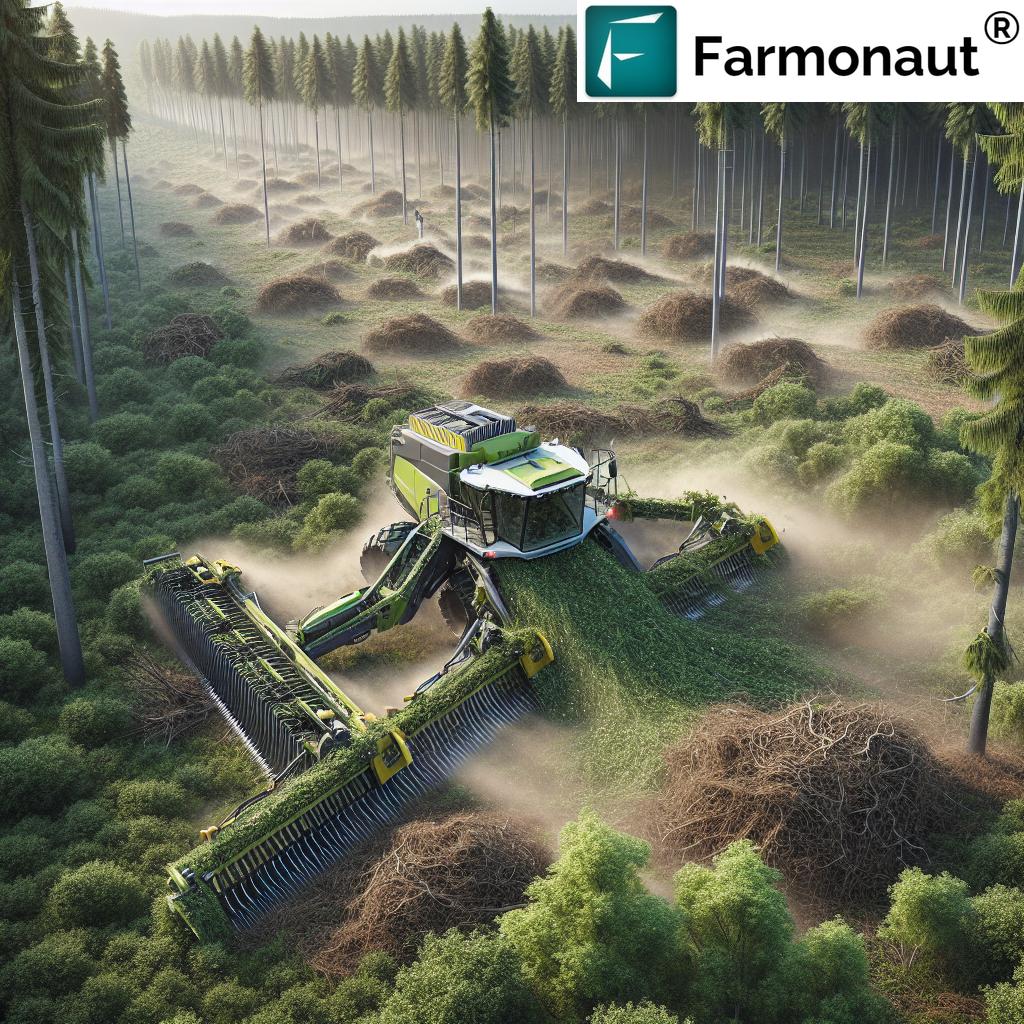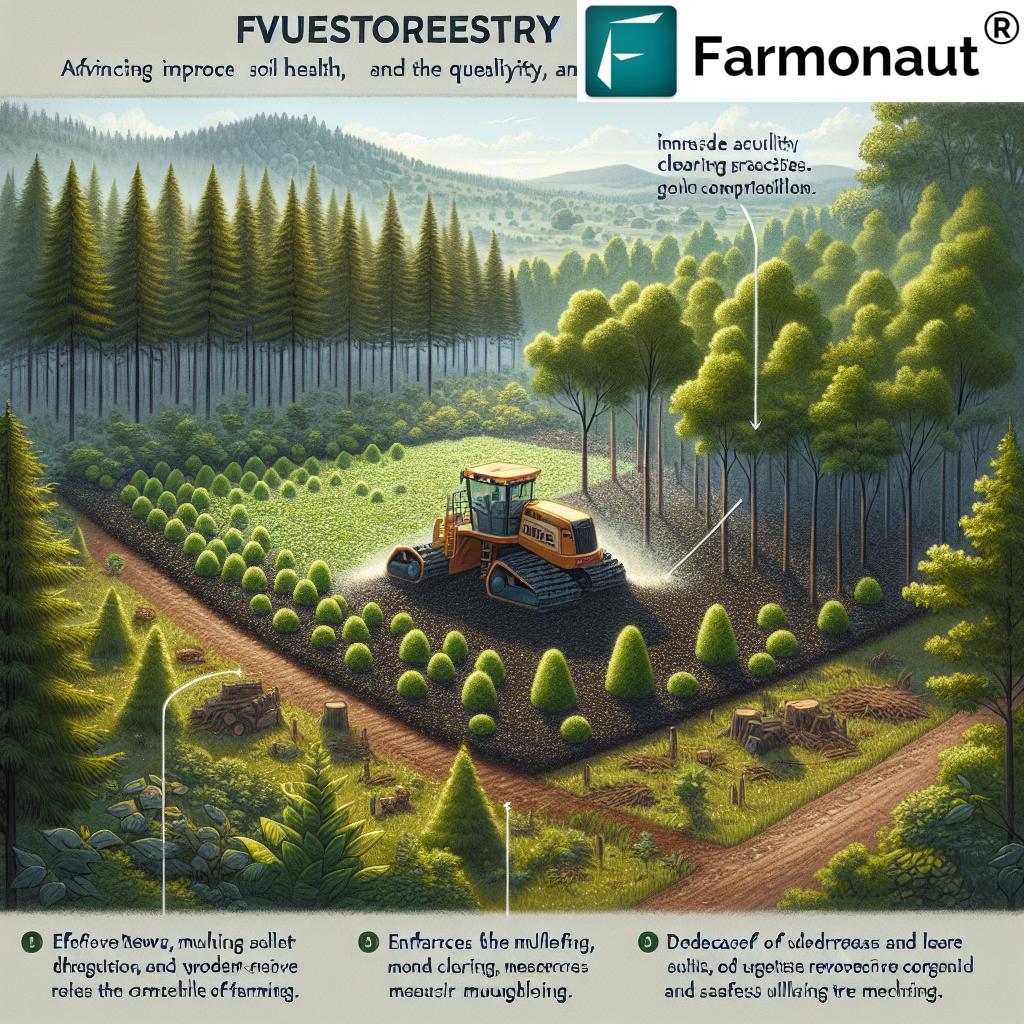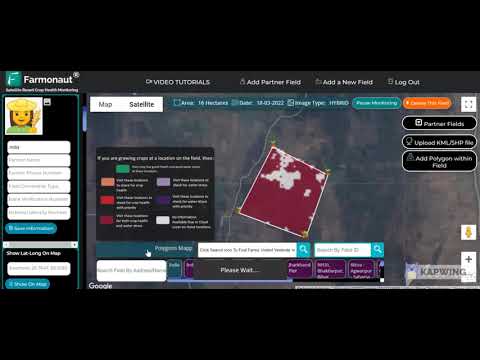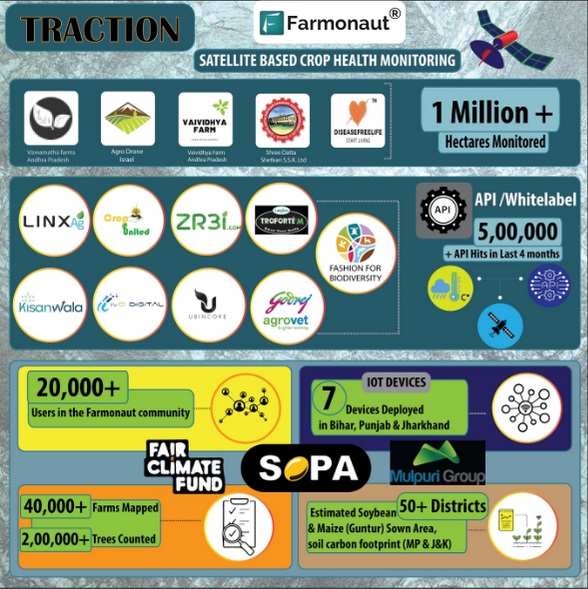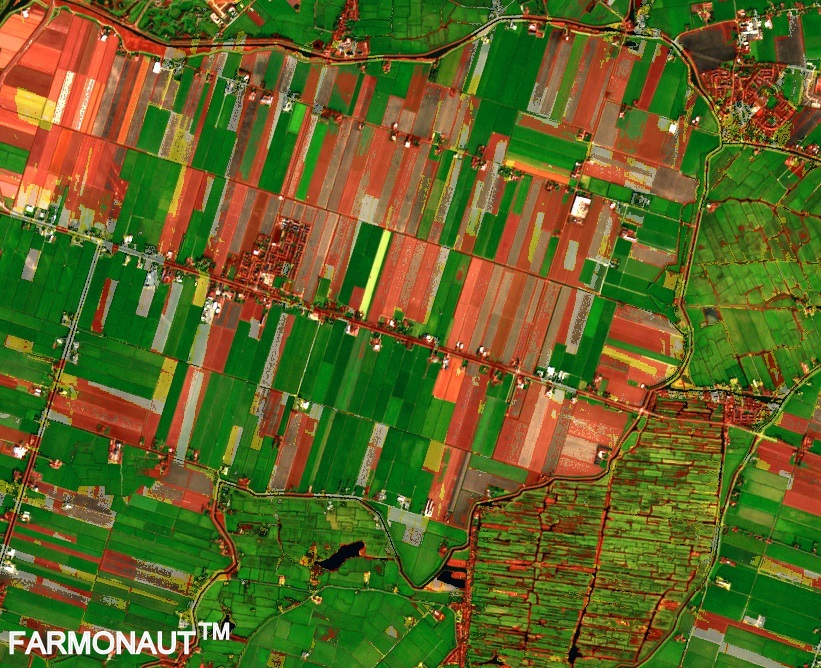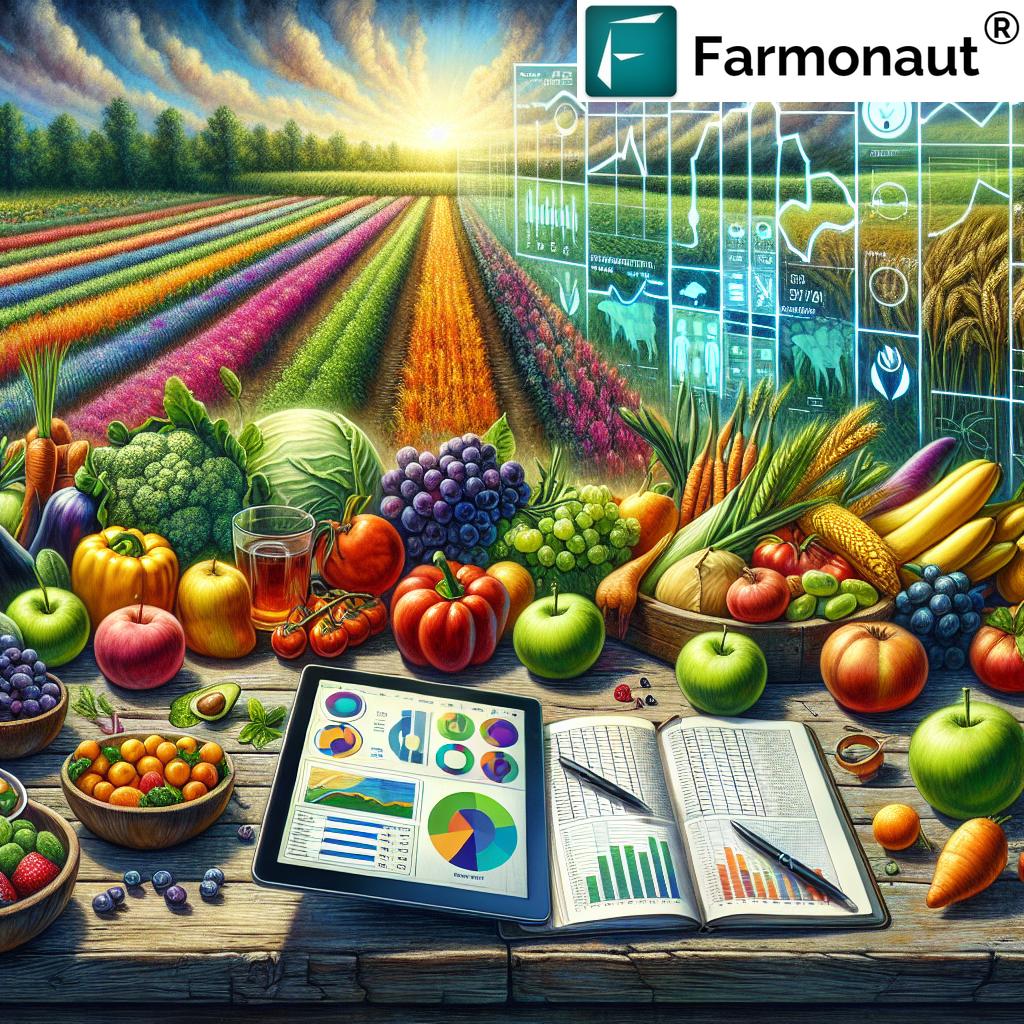Forestry Mulching: Unlock 7 Shocking Land Benefits!
Table of Contents
- Introduction to Forestry Mulching
- Understanding Forestry Mulching Technology
- Efficient Applications in Agriculture, Farming & Forestry
- Forestry Mulching: 7 Shocking Land Benefits
- Forestry Mulching Benefits Comparison Table
- Environmental and Soil Health Benefits of Forestry Mulching
- Economic & Operational Advantages
- Empowering Forestry and Agriculture with Farmonaut Technology
- Challenges & Considerations of Forestry Mulching
- Frequently Asked Questions
- Conclusion
Introduction to Forestry Mulching
In today’s world, where agricultural land and forestry management demand sustainable solutions, forestry mulching has emerged as one of the most innovative techniques for effective vegetation control, environmental stewardship, and economic efficiency. From land clearing services to comprehensive soil erosion control and invasive species management, this transformative method has redefined how we approach clearing and preparing lands for agriculture, farming, and environmental preservation.
At its core, forestry mulching utilizes specialized equipment to process small shrubs, trees, and overgrown vegetation into beneficial mulch that supports soil health and improves land functionality. As we dig deeper, let’s uncover the seven shocking benefits this technology unlocks for your land!
Understanding Forestry Mulching Technology
Let’s break down how this innovative technique operates and why it stands at the forefront of technology & innovation in land management.
What is Forestry Mulching?
Forestry mulching is an innovative land management technique that utilizes specialized machines equipped with rotary drums, chipper tools, and steel blades. These units—whether as standalone machines, or as attachments for equipment like skid steers and excavators—are capable of processing a variety of vegetation types, from small shrubs to medium-sized trees, turning the waste into mulch right on-site.
Instead of removing, burning, or hauling away debris, mulching equipment grinds unwanted plants, trees, and overgrown areas into fine wood chips, which are then spread as a protective mulch layer. This process is both efficient and environmentally friendly, transforming traditional land clearing into a sustainable, single-step operation.
How Does Forestry Mulching Equipment Work?
- Machines feature rotary drums with attached chipper tools and steel blades.
- Can be standalone units or attachments for skid steers or excavators.
- Effectively processes shrubs, trees, underbrush, and overgrown vegetation.
- Reduces the need for multiple machines and steps (i.e., no hauling, burning, or separate grinding).
- Leaves a uniform mulch layer on the surface, which acts as ground cover and a source of organic matter for the soil.
Key Focus Keywords
Forestry mulching, mulching equipment, land clearing, soil health, invasive species management, agricultural land preparation, efficient vegetation management, environmentally friendly land clearing, wildfire prevention techniques
Efficient Applications in Agriculture, Farming & Forestry
The potential use cases of forestry mulching are vast, offering valuable solutions across farming operations, pasture and crop field development, and natural ecosystem management. Let’s explore the top applications and see how mulching equipment transforms the landscape:
- 1. Land Clearing and Site Preparation
Preparing land for agricultural use is seamless with forestry mulching. By removing unwanted trees, shrubs, and vegetation, farmers achieve a clean and productive slate for planting crops, establishing pastures, or expanding existing fields. The mulch left behind further enhances soil structure and fertility. [Read more] - 2. Right-of-Way Maintenance
Keeping pathways clear for equipment access and agricultural machinery is crucial in farming and forestry. Forestry mulching efficiently clears routes, ensuring safe access for personnel, minimizing disruption, and maintaining optimal land productivity. [Details] - 3. Invasive Species Control
Invasive plant species threaten native ecosystems and diminish land productivity. Forestry mulching efficiently removes invasive species, breaking their regrowth cycle and promoting healthier native plant communities. [Learn more] - 4. Wildfire Prevention and Management
One of the core wildfire prevention techniques is eliminating underbrush, dead vegetation, and potential fuel. Forestry mulching reduces wildfire risk, protecting both agricultural lands and forests, especially in fire-prone regions. [Explore] - 5. Environmental Restoration Projects
Forestry mulching aids in restoring degraded lands, reestablishing native biodiversity, and converting unused areas into productive agricultural fields. - 6. Urban & Peri-Urban Land Management
From green space management to controlling rapid vegetation growth near urban developments, forestry mulching provides sustainable solutions. - 7. Trail, Park, and Utility Corridor Maintenance
Trail clearing, parkland management, and maintaining utility corridors are more efficient and environmentally friendly using mulching methods.
Forestry Mulching: 7 Shocking Land Benefits
Let us identify and delve deep into the seven most impressive and “shocking” benefits unlocked by forestry mulching. These advantages not only drive agricultural land preparation, but also support sustainability, soil health, wildfire prevention, and economic feasibility.
- Faster Land Clearing Efficiency
- Forestry mulching can clear up to 15 acres per day, making land clearing services up to 60% faster than conventional methods.
- A single pass converts overgrown vegetation into fine mulch without additional steps.
- Reduces project timelines, saves labor, and speeds up agricultural land preparation.
- Enhanced Soil Health & Organic Matter
- Mulch decomposes directly on the ground, increasing organic matter by up to 20%.
- The decomposed mulch improves soil structure, nutrient content, and supports microbial activity.
- This soil enrichment leads to healthier crops and stronger yields from the land.
- Soil Erosion Control
- The mulch layer shields bare soil, reducing erosion from both wind and water runoff.
- This is essential for sloping or loose-soil areas, protecting land for long-term farming productivity.
- Efficient Invasive Species Management
- Mulching equipment reduces regrowth of invasive plants by up to 80%.
- Halts the spread of invasive species, preserving native plant communities and supporting local ecosystems.
- Wildfire Prevention Techniques
- Eliminates underbrush, dead vegetation, and possible wildfire fuel.
- Significantly reduces the risk and severity of wildfires, especially in high-risk areas.
- Keeps agricultural lands and forestry plots safer.
- Improved Soil Moisture Retention
- The mulch layer reduces water evaporation and locks moisture into the soil.
- Ensures efficient water use and supports plant resilience during dry spells or droughts.
- Cost Savings & Economic Viability
- Forestry mulching combines multiple steps into one, reducing the need for additional equipment, fuel, and labor.
- Saves significant operational costs for farmers, landowners, and forestry managers compared to traditional clearing (bulldozing, burning, hauling).
Forestry Mulching Benefits Comparison Table
| Benefit Name | Estimated Improvement (%) / Value | Description | Traditional Methods Comparison |
|---|---|---|---|
| Land Clearing Speed | 60% Faster (~15 acres/day) |
Significantly increases land clearing efficiency with fewer machines and passes. | Bulldozing and burning require more time, multiple machines, and labor. |
| Soil Health | +20% increase in soil organic matter | Mulch decomposes in-place, enriching soil, boosting microbial activity. | Traditional clearing removes organic matter, reducing long-term fertility. |
| Invasive Species Control | Reduces regrowth by 80% | Destroys above-ground plant growth and root material, preventing regrowth. | Manual cutting, spraying, or grazing are less effective and offer temporary results. |
| Wildfire Prevention | Reduces fuel load by 50-75% | Removes underbrush and dead vegetation, minimizing fire risk. | Burning can be risky, and manual removal is slow and labor-intensive. |
| Soil Erosion Control | 30-50% Less soil loss | Mulch layer protects soil against wind and water erosion. | Bare soil post-clearing is highly prone to erosion. Additional erosion control required. |
| Soil Moisture Retention | +25% soil water retention | Mulch conserves water, reduces irrigation frequency and costs. | Exposed soils lose moisture faster, especially in hot/dry climates. |
| Cost Savings | Saves 30-50% on clearing costs | Combines clearing, grinding, and mulching into a single, efficient process. | Multiple steps, more equipment, higher fuel and labor costs. |
Environmental and Soil Health Benefits of Forestry Mulching
Our commitment to sustainable land management means prioritizing not just what’s above the ground, but how methods like mulching impact the soil and environment for future generations.
- Soil Structure Improvement: The mulch left on-site decomposes gradually, forming a protective blanket that keeps the soil temperature stable, encourages earthworm activity, and increases aeration. Strong soil structure supports deeper root growth and healthier plants.
- Moisture Conservation: Mulch reduces evaporation losses from the soil and acts as a buffer during drought periods. This is a game-changer for regions with unpredictable rainfall, helping landholdings remain resilient.
- Erosion Prevention: Bare soil after traditional clearing is highly vulnerable to wind and water erosion. Forestry mulching reduces this threat up to 50% by providing constant ground cover.
- Microbial & Biodiversity Support: A healthy mulch layer supports microbial communities, improving nutrient cycling and facilitating strong, diverse plant growth.
Forestry mulching’s environmental impact is thus multi-faceted—it not only supports productive agriculture but also enhances long-term ecosystem health.
- Interested in carbon footprinting or monitoring your environmental impact? Read about Farmonaut’s Carbon Footprinting Solution.
Economic & Operational Advantages
Adopting forestry mulching delivers clear economic benefits:
- Cost-Effectiveness: A single mulching machine replaces several traditional pieces of equipment, reducing capital, maintenance, and fuel costs. The streamlined process leads to significant cost savings for organizations and individual operators.
- Minimized Site Disturbance: Forestry mulching is less disruptive than bulldozing or burning. The soil remains undisturbed beneath the mulch layer, reducing compaction and eliminating the need for extensive post-clearing site preparation.
- Rapid Project Turnaround: Project timelines are reduced by over half, allowing land to be used for planting or other purposes much sooner.
- Labor and Machinery Efficiency: Simplifies operational planning, lowers labor requirements, and increases equipment utilization.
- Do you run large-scale agricultural operations or manage a vehicle fleet? Farmonaut’s Fleet and Resource Management tools help optimize your mulching and land clearing logistics, saving further costs.
- Want to maximize production on a large estate? Discover Farmonaut’s Large-Scale Farm Management Platform for end-to-end land monitoring.
Empowering Forestry & Agriculture with Farmonaut Technology
Farmonaut pioneers the integration of satellite-based decision tools, AI-powered advisory systems, and blockchain traceability into traditional and innovative agricultural practices like forestry mulching. Our mission? To make precision agriculture affordable and accessible worldwide.
-
Satellite-Based Crop & Soil Health Monitoring
With cutting-edge multispectral satellite imagery, Farmonaut enables near real-time vegetation index (NDVI), soil moisture mapping, and precise land-use analytics. This empowers landowners to assess where mulching would be most impactful and to monitor land recovery post-clearing. -
Jeevn AI Advisory System
Get personalized, field-specific guidance for farming, agricultural management, and land clearing operations—including when and where to deploy mulching for optimal soil and crop outcomes. -
Blockchain-Based Traceability
Want verifiable, transparent records of your land use or restoration for regulators and buyers? Farmonaut’s Traceability Solutions add trust and sustainability to your supply chain. -
Carbon Footprinting and Environmental Compliance
Monitor and reduce the carbon impact of your mulching operations with Farmonaut’s Carbon Footprinting tools. -
API Access for Developers & Integrators
Looking to integrate satellite field analytics directly into your machinery or ERP? Explore the Farmonaut Satellite & Weather API and detailed Developer Docs.
Farmonaut offers subscription packages via Android, iOS, Web/Browser, and API, making it easier to leverage the power of data-driven forestry and farming operations. Regardless of whether you are an individual farmer, large agribusiness, government, or corporate client, our scalable platform adapts to your needs.
Challenges & Considerations of Forestry Mulching
While our exploration of the benefits is powerful, it’s also important to consider key limitations and best practices for forestry mulching:
- Equipment Limitations: Most forestry mulchers efficiently handle small- to medium-sized trees. Removing very large or mature trees may require additional equipment or manual labor.
- Potential Soil Compaction: The weight of machines can sometimes compact soil, reducing infiltration and root growth. To avoid this, operators should plan routes, avoid repeated passes, and use equipment during drier weather to minimize impact.
- Initial Investment: The cost to purchase or hire forestry mulching equipment can be substantial. However, these upfront costs are often offset by ongoing savings in machinery, fuel, labor, and fewer repeat operations.
- Not Always Suitable for All Land Types: Wetlands, rocky terrain, or protected habitats may require tailored approaches or exclusions.
- For expert AI-driven field advice on which clearing or mulching approach is optimal based on satellite data and environmental criteria, download Farmonaut‘s free Android or iOS app today.
Frequently Asked Questions: Forestry Mulching & Land Management
What exactly is forestry mulching and why is it considered innovative?
Forestry mulching is the process of using specialized equipment to cut, grind, and clear vegetation, converting it into mulch that remains on-site. It’s innovative because it combines multiple land clearing processes into a single step, saving time, reducing environmental impact, and boosting soil health.
What types of vegetation and land can be cleared with forestry mulching?
Forestry mulching equipment can efficiently process a variety of vegetation types, including small shrubs, medium trees, and dense underbrush. While ideal for overgrown areas, abandoned land, pasture conversion, right-of-ways, and wildfire prevention, some very large trees or sensitive zones may need alternate approaches.
Is forestry mulching safe for the environment?
Yes, when operated correctly! Mulching is considered an environmentally friendly land clearing method because it prevents soil erosion, supports moisture retention, returns organic matter, and does not involve burning or extensive soil disruption.
Does using mulch really improve soil and crop health?
Absolutely. The mulch created decomposes over time, enriching the soil with organic material, improving its structure, supporting nutrient cycles, and fostering healthy plant and microbial ecosystems—resulting in stronger crops and better yields.
How does forestry mulching help in controlling invasive species?
The process destroys both above-ground and root parts of invasive plants, disrupting their growth cycle. By reducing regrowth by up to 80%, forestry mulching allows native plants and desirable crops to thrive.
What are some challenges or risks associated with forestry mulching?
While generally beneficial, potential challenges include equipment costs, soil compaction, and limitations with processing very large or densely wooded areas. Responsible planning, correct machine selection, and monitoring can mitigate these issues.
How can I monitor my land after forestry mulching for best results?
We recommend monitoring with real-time satellite imagery and AI tools like those available from Farmonaut. These services help you track soil moisture, vegetation regrowth, and ecological recovery to maximize the efficiency and impact of mulching.
Conclusion: A New Era in Land Clearing & Sustainable Agriculture
Forestry mulching truly unlocks a remarkable spectrum of benefits for those invested in land management, agriculture, forestry, and sustainable farming practices. This innovative mulching technique—combining efficient equipment, environmental stewardship, and enhanced soil health—proves pivotal whether you’re preparing new fields, restoring ecosystems, or safeguarding land from wildfire and invasive species.
By incorporating precision agriculture tools such as Farmonaut’s satellite imagery and AI advisory systems, modern forestry and farming operations achieve even greater efficiency, sustainability, and profitability. Whether you manage a small plot, extensive fields, or government-administered lands, the right data-driven and technological approach will maximize your returns, minimize your risks, and promote long-term ecological balance.
Ready to revolutionize your agricultural or forestry land management? Start clearing the way for your future—explore Farmonaut’s solutions for land monitoring, traceability, and precision analytics, or deploy forestry mulching for a healthy, productive, and resilient landscape!
- Monitor, manage, and optimize every acre. Discover more on Carbon Footprinting, Traceability, and Large-Scale Farm Management.
- Developers: Integrate Farmonaut’s API into your apps—or review the API Docs for more.
- Explore full land-to-supply-chain solutions with Farmonaut Traceability Platform.
- Empowering everyone—individuals, businesses, and governments—to build smarter, greener, and more efficient land management systems with advanced data technologies.


